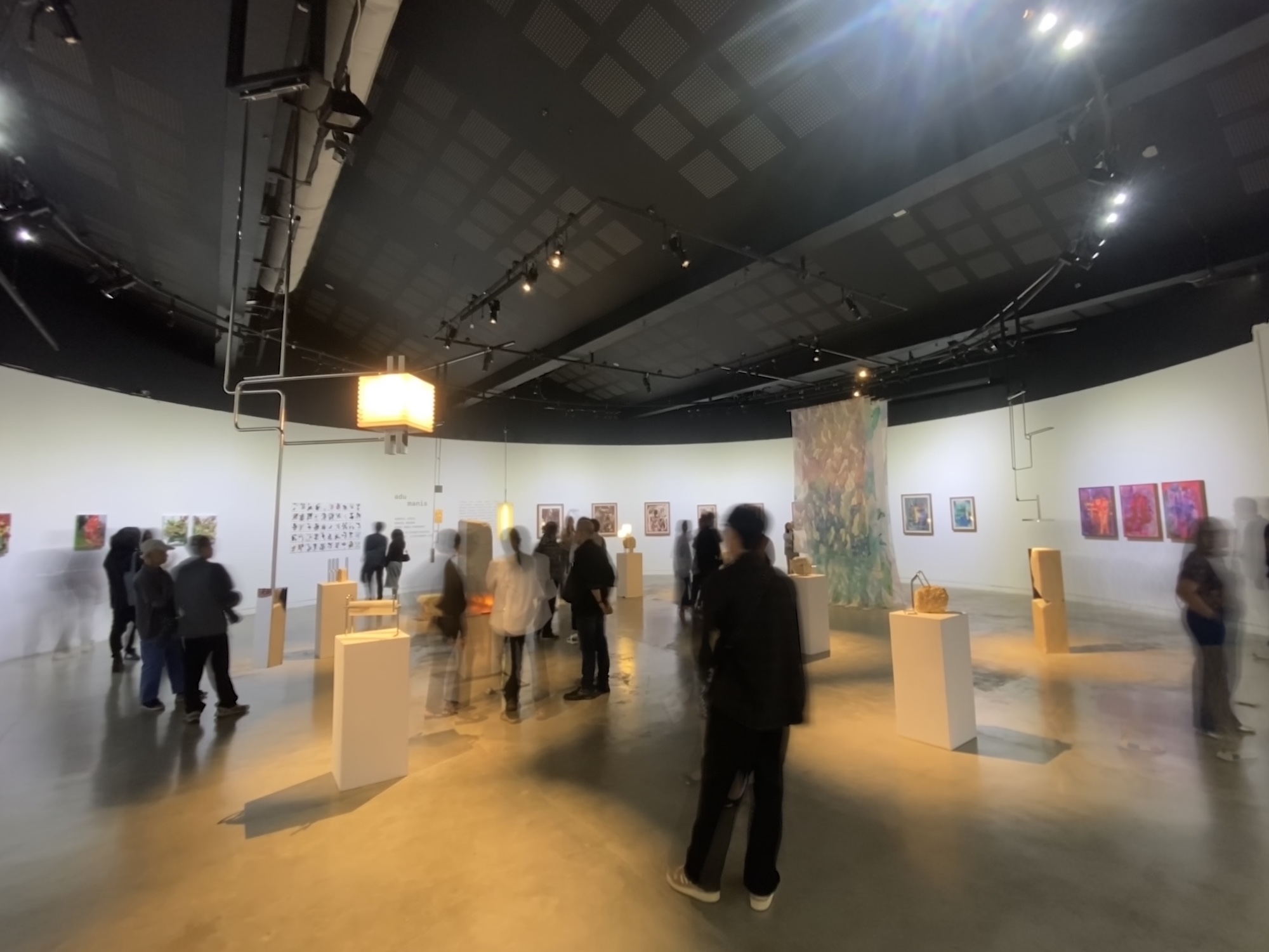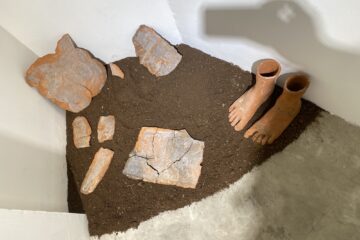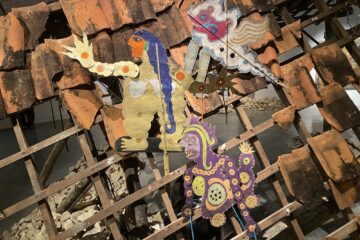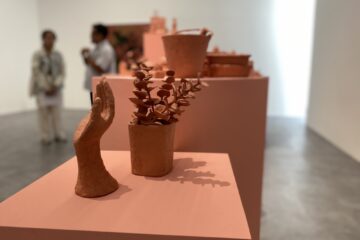Their works reject literal narratives, instead exploring a shared terrain: the boundaries of non-figurative art through its most primal elements—form, color, and texture.
There was a moment in Indonesian art history whose echoes still resonate today. That moment was marked by the emergence of the New Art Movement (Gerakan Seni Rupa Baru, or GSRB) in the mid-1970s. As a response to the constraints of traditional visual arts, this movement burst forth with a spirit of renewal, challenging the dominance of conventional painting, sculpture, and graphics. Its origins can be traced to the provocative “Black December Statement of 1974” and the heated debates between Oesman Effendi and S. Sudjojono regarding the existence of Indonesian painting.
Within the broader narrative of GSRB, Sanento Yuliman emerges as a pivotal figure. As a critic, lecturer, and thinker, he articulated the “New Perspective” in the catalog for the 1975 New Art Exhibition, a text that became a manifesto for the movement. So, when the curatorial essay for the “Adu Manis” exhibition at Salihara Gallery (organized in collaboration with ArtSociates) opens with a quote from Sanento, my mind is immediately transported to the past, weaving threads between history and possibility. Could this exhibition be an attempt to revive the ideas championed by GSRB?
“Artists today differ from those of the past,” wrote Sanento Yuliman, as quoted by curator Rifandy Priatna in the opening of his curatorial essay. In Sanento’s view, the visual memory of contemporary artists has transformed into a kind of “imaginary museum”—a mental space overflowing with images from exhibitions, art reproductions, and the deluge of digital media. Amid this dense visual landscape, style is no longer a rigid monolith defining an artist’s identity. It has become a fluid, dynamic field of experimentation: a response to the abundance of imagery and a rebellion against modernist dogmas demanding consistency.
Amid this dense visual landscape, style is no longer a rigid monolith defining an artist’s identity.
This shift extends beyond the creative process to how we, as viewers, experience and interpret artworks. The way society consumes information has fundamentally changed, driven by technology that compresses space and time. Real-time access to visual knowledge, the ease of connecting with artists digitally, and the flood of information have created a new ecosystem. In this world, artists, artworks, and audiences coexist in the same temporal and spatial plane, enabling a more democratic exchange: a multi-perspective dialogue between the viewer’s personal lens, the artist’s individual vision, and the formal context of the work itself. This, Rifandy asserts, is the conceptual foundation of the “Adu Manis” exhibition.
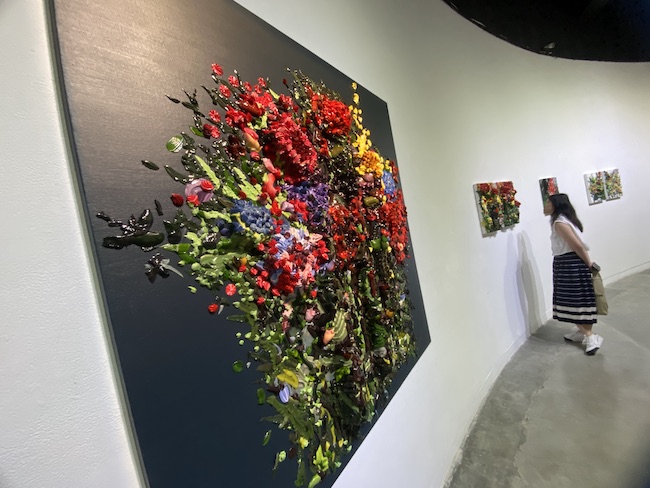
The term “adu manis,” chosen as the exhibition’s title, refers to a woodworking technique where two surfaces are joined at a precise 45-degree angle to form a perfect 90-degree connection. In the context of this exhibition, it serves as an allegory for creative convergence. Each encounter sparks friction: an energy born from elements interacting, clashing, and negotiating.
The Friction of Three Visual Languages
The “Adu Manis” exhibition features three Bandung-based artists: Gabriel Aries, Reggie Aquara, and Rendy Pramudya. Their works reject literal narratives, instead exploring a shared terrain: the boundaries of non-figurative art through its most primal elements—form, color, and texture.
Upon entering the gallery, the eye is immediately drawn to a painting resembling an exploding bouquet of flowers frozen in dynamic motion. This is Reggie Aquara’s work from the Painters Bouquet series. The square canvas, set against a stark black background, creates a dramatic stage where the central element—a dense mass of flowers—looms almost brutally.
These flowers are not painted but sculpted from thick, layered acrylic paint, creating a tactile, three-dimensional effect with a rough, cake-frosting-like texture, applied with spontaneous, passionate abandon. Within the exhibition’s curatorial discourse, Reggie’s work embodies the “imaginary museum” and a defiance of modernist dogma. It boldly challenges the boundary between traditional painting and material experimentation, asserting that beauty emerges from imperfection and spontaneity, like wildflowers blooming without constraint.
Dominant colors—gradations of deep red, pink, orange, and bright yellow at the top—radiate the intensity of fire or an energy explosion. Below, a transition to dark and light greens suggests stems and leaves, with small white flecks resembling dew or wildflowers. Scattered paint splatters around the bouquet enhance the sense of organic movement and captured chaos.
The work feels alive, pulsating. Its raised surface invites touch, as if the paint remains wet and malleable. The title Painters Bouquet suggests an offering from the artist to themselves or the viewer, where the paint itself becomes the protagonist, not merely a tool.
The thick, layered paint can be read as a metaphor for accumulated emotions—an uncontrollable burst of feeling. The fiery reds and oranges symbolize passion, anger, or vitality, while the greens at the base evoke roots, growth, or organic calm. In the dialogue of “adu manis,” Reggie seems to ask: Where lies the boundary between painting and sculpture, beauty and chaos, control and release?
Where lies the boundary between painting and sculpture, beauty and chaos, control and release?
Reggie’s other works in the exhibition carry the same spirit, though through varied figurative approaches. His signature decorative pastry technique transforms into a unique contemporary visual language. The frozen clumps of paint resemble fossils of spontaneous gestures, capturing the energy of the creative moment.
Moving on from Reggie’s works, Rendy Pramudya’s paintings offer a wholly different world. In his Wirama Di Alam Batas series, three abstract expressionist paintings feature fluid, dynamic, layered organic forms. These forms do not depict real objects but resemble flows of energy or subconscious shapes, painted with an intense, contrasting palette to create striking visual depth.
In one painting, a deep blue-purple background sets the stage for a central form in orange, yellow, and red that appears to melt downward, like fire or abstract geological formations. Thin, curving black lines add vertical motion and tension, as if the form is “exploding” from within the canvas.
Another painting features a softer pink-purple background supporting a dominant mass of deep red, purple, and dark green forms that blend into one another. Reminiscent of bodily organs or turbulent clouds, it combines delicate strokes and rough brushwork for layered texture. Subtle pink and light blue elements add contrast, creating a more introspective, less intense mood than the first.
The third painting presents a warm reddish-orange background, with dominant dark green, deep blue, and purple forms resembling dripping liquid or fluid droplets. Scattered black specks and random lines enhance the organic feel, as if capturing a transition between solid and liquid states. This composition feels the “wildest” of the three, with plant-like or particle-like elements dispersed across the canvas.
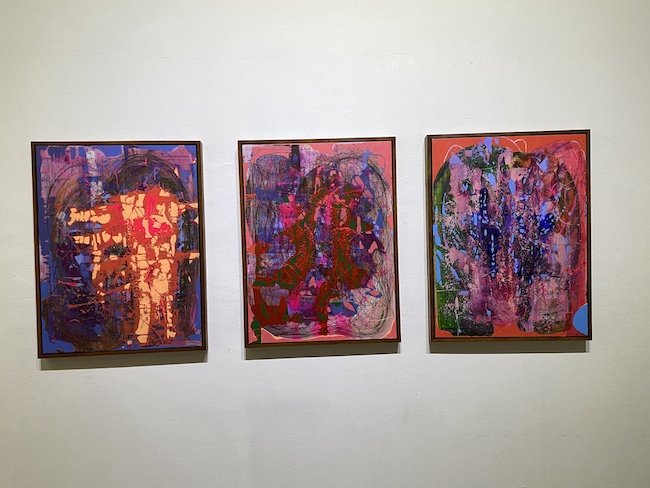
Collectively, the Wirama Di Alam Batas series can be interpreted as a metaphysical exploration of the boundaries between physical reality and the unseen realm of the mind. The title—“Wirama” (rhythm or cadence in Javanese/Sanskrit) and “alam batas” (liminal realm)—points to rhythm in a threshold space, where organic forms embody existential uncertainty, an eternal struggle between control (order) and chaos (freedom).
Rendy’s paintings visualize the subconscious: flowing forms symbolize unarticulated ideas, while sharp color contrasts reflect underlying emotional and spiritual tensions. Beyond paintings, Rendy also presents an installation that serves as a key moment in the exhibition. Comprising four layers of transparent silkscreen fabric, it functions like an anatomical dissection of his process. Each layer reveals a usually hidden aspect of consciousness beneath the finished canvas’s surface.
This approach is not merely technical but an invitation to explore the ontology of creation—the fundamental essence of how a work is born. The four layers, typically fused into a cohesive visual illusion in the final work, are now exposed as independent entities. This allows viewers to witness an intimate dialogue between spontaneous motoric gestures (subconscious impulses) and deliberate composition (the artist’s reason and control).
This installation expands Rendy’s conceptual exploration of materials. By deconstructing the process into transparent layers, he not only showcases the final product but retraces the “genesis” of his organic forms. It’s like unfolding a metaphysical map of the mind, usually concealed behind the completed canvas.
Thus, the installation becomes a key to understanding his entire body of work in the exhibition. It is a meta-work—a piece about the act of creation itself—clearly reflecting the conceptual foundation of “Adu Manis”: a multi-perspective dialogue that invites us not only to see the final result but to feel the pulse and long breath of creation.
In the center of the exhibition space, Gabriel Aries offers a striking contrast through hard, assertive materials: metal, stone, and resin. Responding to the gallery’s challenge, Gabriel doesn’t merely place his works but uses light as a sculptural element equal to physical materials.
Gabriel’s approach is architectural, with careful attention to spatial scale. He creates suspended sculptures that radically redefine the traditional relationship between object, space, and viewer. Some works are deliberately hung at varying heights, creating a visual dynamic that encourages the viewer’s eye to move vertically, beyond the conventional horizontal gaze.
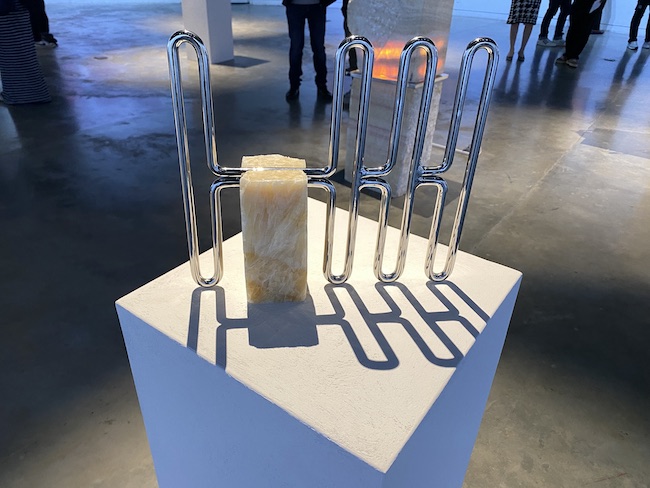
One work, made of transparent resin suspended on polished stainless steel, refracts light to unexpected corners of the room. The piece generates ever-changing light patterns as viewers move, making them not just passive observers but integral parts of the work. Elsewhere, a mirror-polished stainless steel piece, hung at a specific angle, captures and reflects fragments of the exhibition space and passing viewers, blending the work with its environment in an almost inseparable way.
Gabriel deliberately considers how his works interact from multiple perspectives. A sculpture suspended in the center of the room can be viewed from 360 degrees, offering a different experience from each angle. This multidimensional approach creates a dialectic between strength and fragility, opacity and transparency, which defines his work.
Through this approach, Gabriel doesn’t merely place works in space but fosters a symbiotic relationship where the work and space define each other. Each piece becomes a portal that alters our perception of the surrounding environment while inviting reflection on the boundaries between art object, architecture, and perceptual experience. In the context of “Adu Manis,” Gabriel’s works spark a conversation about how materiality and immateriality—the solid and the translucent—can unite in dynamic harmony.
Ultimately, this exhibition is not just a visual display but a philosophical statement. If the initial question was whether “Adu Manis” seeks to extend the legacy of GSRB, the answer lies not in mimicking its forms but in its fidelity to its core spirit: a relentless questioning of boundaries, a celebration of experimentation, and, most importantly, a belief that visual art is a living field of thought. Thus, the works presented here emerge as representations of the “imaginary museum”—a space perpetually debated, reinterpreted, and renewed.
- Cover image: Hidayat Adhiningrat
- Dancing on the Grave of Severed Memories - September 30, 2025
- The Magic of Objects in Stillness - September 30, 2025
- The Storytelling Soil - September 30, 2025

